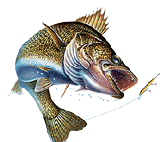by Ron Anlauf
By mid summer the hot early season action on a lot of good walleye lakes
can slow down just a bit, but it doesn’t completely stop and can still be
pretty darn good. In fact tremendous catches are still being made,
especially when it comes to the heavy duty models.  You
just have to be ready to make some changes and not get stuck doing the same
things in the same places.
You
just have to be ready to make some changes and not get stuck doing the same
things in the same places.
One of the first things you can do is try shifting into a higher gear and
pick up the pace by employing a faster presentation. The ultra slow tactics
that were so deadly just a month or so earlier may be coming up empty now.
Techniques that allow you to cover plenty of water are the ticket, and
includes trolling spinners and crankbaits.
Spinners are designed to deliver live bait with an element of speed and
speed is where it’s at for hot summer walleyes. A typical spinner rig
includes a multiple hook harness like Northland Tackle’s Rainbow Crawler
Harness combined with a big fat night crawler. Blade color is a
consideration and it can pay to experiment which will help you fine tune a
productive pattern. In other words; if you’re catching some fish you might
be able to catch even more with a simple color change. Northland Tackle
has some awesome new blade colors including metallic fish scale blades along
with red hooks and pearl beads. They also come with a five foot leader
which is about as much as you need and gives you the option of shortening it
up if the situation requires it.
Another good spinner option includes using minnows which aren’t usually
associated with summer walleyes, but the combination can be deadly. A
minnow and spinner trolled at a good clip can elicit strikes from walleyes
that turn their noses up at just about everything else. Effective spinner
minnows include larger fatheads, chubs, or even small suckers, and will
depend on what’s available.
Another consideration for dealing with late summer eye’s is location, and
looking a little deeper is usually a good bet, but not always. Clear lakes
provide the best opportunity for finding deeper holding walleyes and deep
can mean forty feet or more. By looking over deeper structure with good
electronics you can quickly find out if there is any potential for finding a
deeper vein of fish. With incredible electronics like Humminbird’s 997C
(which is a color graph and G.P.S. combination with Side Imaging) you can
take a 180 degree swath and cover a lot more water and see it like you’ve
never seen it before.
Side Imaging allows you to see what’s below as well as what’s to either
side, out to 150 feet. Whatever you’re using take a look at deep points,
offshore humps, transition lines, and break lines and make note of any sign
of life including schools of bait as well as fish holding close to the
bottom. If you’re not marking any of the above keep moving until you do.
Try moving deeper and shallower until you begin to see concentrations of
bait and fish.
While there is a shallow to deep migration on most of our clearer lakes,
just the opposite can be true on bodies of water that darken up. Many lakes
start out relatively clear and then darken up by mid summer due to algae
blooms and turbidity. In that case you may be restricted to working
shallow water, as shallow as a few feet in the most extreme cases. An
option is the suspension factor whereby walleyes lift high off the bottom
out in the middle of nowhere. It’s a phenomenon that happens more often
than you think and may be your best be for finding active late summer
walleyes. Try looking outside classic walleye structure with your depth
finder and head out into deeper water, including the main lake basin, and
look for life. If you’re seeing suspended schools of bait there is an
excellent chance that you’ll also find walleyes. Look for wandering ‘eyes
to hold just under the bait, and even in the middle of it. They’ll hold
just below their meal ticket until they decide to turn on, where they can
simply move up into a school of bait and chow down.
Approaching suspended fish can be as simple as trolling a crankbait like
a 3/8oz Walleye Diver with a bunch of line out while looking for a few
biters. Even if you’re marking plenty of fish chances are than only a
portion will be active at any given time and you’ll have to get your bait in
front of as many fish as possible to help up your odds of making contact.
If you get serious about trolling for suspended walleyes there’s plenty of
good info available including books and charts that can help you get a bait
to run at a specific depth, with a certain weight line, as well as an exact
speed. Fortunately you don’t have to be exact to be effective, but being
exact will make you more efficient.
See you on the water.


 You
just have to be ready to make some changes and not get stuck doing the same
things in the same places.
You
just have to be ready to make some changes and not get stuck doing the same
things in the same places.